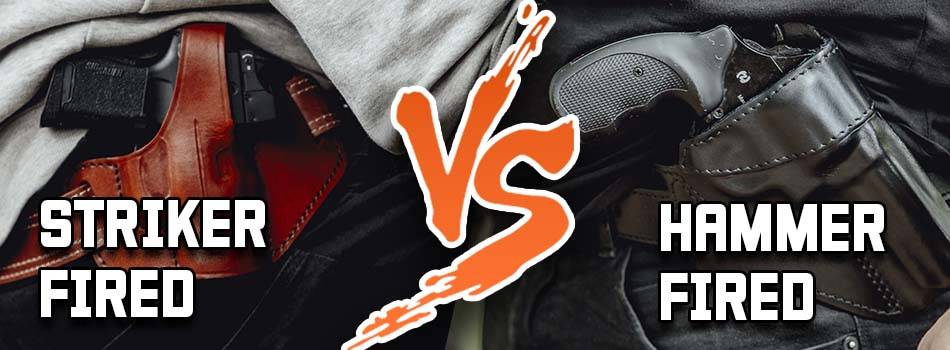
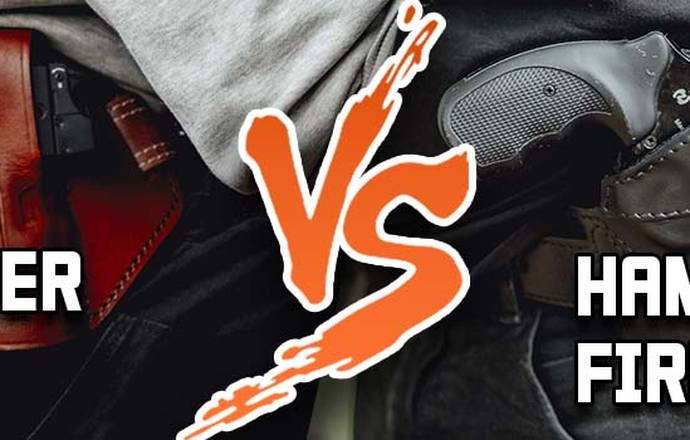
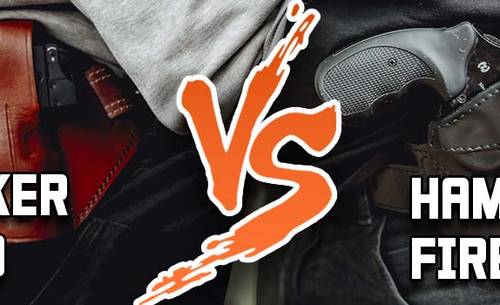
Table of Contents
This is a pretty fundamental choice: striker-fired vs. hammer-fired.
Face it, there are a lot of handguns out there. Unless you’re unlucky enough to be in a heavily restricted state or, God forbid, the socialist mecca known as Canada, you have many options available to you. And choosing the right type of firearm is going to be a pivotal decision.
Each type offers unique benefits and drawbacks, directly impacting user experience from handling and safety to maintenance and performance.
This article aims to dissect these two prevalent firing systems, offering a comprehensive comparison to enlighten our dear readers and facilitate a kickass choice tailored to individual needs and preferences.
STRIKER FIRED VS HAMMER FIRED: THE BASICS
STRIKER FIRED MECHANISMS
At its core, a striker-fired pistol simplifies the firing process. It eliminates the traditional hammer, opting instead for a spring-loaded striker integrated within the slide.
When the trigger is pulled, this striker is propelled forward, striking the primer to discharge the firearm. This mechanism results in a consistent trigger pull, a feature that advocates argue enhances accuracy and reliability, especially for those under stress or in dynamic shooting scenarios.
HAMMER-FIRED MECHANISMS
In contrast, hammer-fired pistols feature an external or internal hammer that, when the trigger is pulled, swings forward to hit a firing pin. This pin, in turn, strikes the primer. Then gun go boom.
This type of mechanism can offer:
- Single-action (SA)
- Double-action (DA)
- A combination of both (DA/SA) modes can provide a versatile shooting experience
Proponents of hammer-fired handguns appreciate the tactile feedback and the ability to manually cock the hammer for a lighter, crisper trigger pull on the first shot in SA mode.
HOW TO VISUALISE THIS
To aid in understanding, imagine the striker-fired mechanism as a sleek, modern sports car with an automatic transmission—designed for simplicity and efficiency. In contrast, the hammer-fired pistol is akin to a classic car with a manual gearbox, offering tactile feedback and control that enthusiasts treasure.
STRIKER FIRED VS HAMMER FIRED: PROS AND CONS
ADVANTAGES OF STRIKER-FIRED PISTOLS
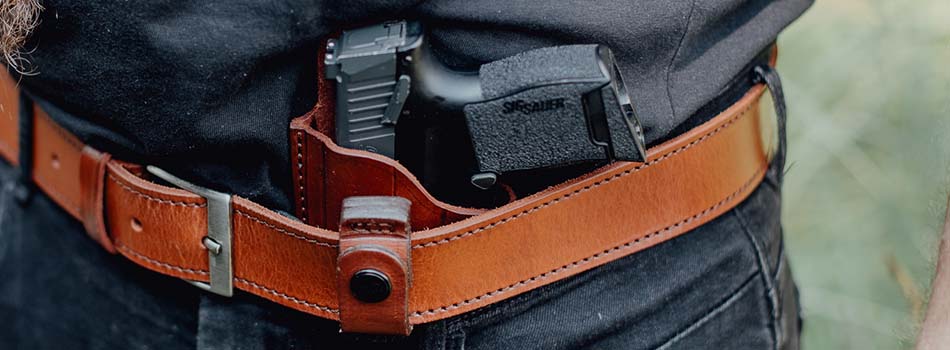


Let’s start with the pros of the striker version.
CONSISTENCY IN TRIGGER PULL
One of the most lauded advantages of striker-fired pistols is the uniformity of their trigger pull. Each shot feels the same, which can significantly enhance accuracy and confidence, especially for beginners or in high-pressure situations.
This predictability allows for easier training and muscle memory development.
DESIGN SIMPLICITY AND RELIABILITY
Striker-fired guns boast fewer moving parts, contributing to a streamlined and inherently reliable design. This simplicity means there’s less that can go wrong, making them highly dependable in various conditions.
Additionally, the absence of an external hammer makes them sleeker, reducing the risk of snagging when drawing from a holster.
DISADVANTAGES OF STRIKER-FIRED PISTOLS
PERCEIVED LACK OF TACTILE CONTROL
I’m saying perceived here because it’s not the same experience for everyone.
While the consistent trigger pull is an advantage, some shooters miss the tactile feedback and control offered by a hammer that can be physically cocked. I’ve found this preference is particularly noted among enthusiasts accustomed to traditional firearms or those who prioritize shot anticipation and control over simplicity.
ADVANTAGES OF HAMMER-FIRED PISTOLS
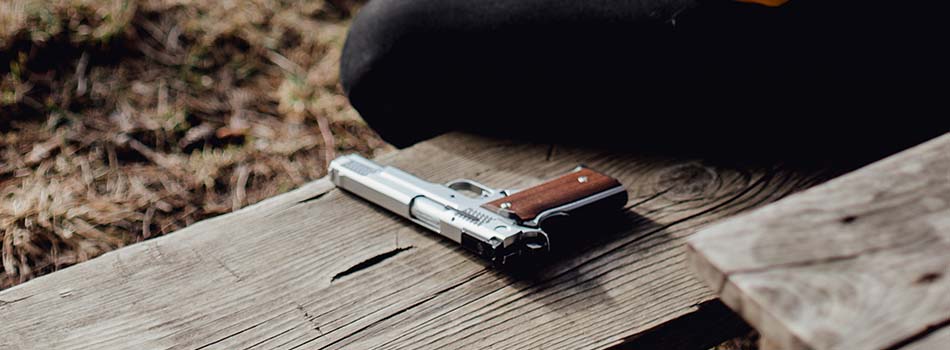


VISUAL AND TACTILE INDICATION OF THE HAMMER’S POSITION
The external hammer of these pistols provides both a visual and tactile indicator of the gun’s status, offering an added layer of safety and control. Shooters can easily ascertain whether the firearm is cocked and ready to fire, which can be reassuring and allows for more deliberate action.
POTENTIALLY SAFER IN CERTAIN CARRY CONDITIONS
For some, the ability to carry a pistol with the hammer down, especially in double-action mode, feels inherently safer. The initial heavy trigger pull of a double-action shot acts as an additional safety feature, reducing the risk of accidental discharge.
DISADVANTAGES OF HAMMER-FIRED PISTOLS
COMPLEXITY IN DESIGN LEANDER TO MORE MAINTENANCE
The intricate mechanics of hammer-fired systems can necessitate more maintenance and care. The presence of more moving parts, such as springs, levers, and the hammer itself, means there’s more that requires attention and upkeep, potentially increasing the lifetime cost and effort of ownership.
STRIKER VS HAMMER: PERFORMANCE AND USABILITY
Hammer-fired pistols offer the versatility of double-action/single-action (DA/SA) triggers, allowing for a heavy, deliberate first pull followed by lighter subsequent shots.
This can be advantageous for those who prioritize safety and control over rapid fire. Conversely, striker-fired pistols offer a consistent trigger pull, which, while it may lack the DA/SA versatility, provides a predictability that can lead to faster proficiency and comfort for many shooters.
SAFETY CONSIDERATION AND MECHANISMS
Both systems incorporate modern safety features, though their mechanisms differ.
- Striker-fired pistols often include integrated safety mechanisms such as trigger safeties, which prevent firing unless the trigger is deliberately pressed
- Hammer-fired pistols, with their manual hammers and decockers, offer a physical interaction with the firearm's safety features, appealing to those who prefer an extra level of manual control
PERSONAL PREFERENCE AND COMFORT
Personal preference and comfort, of course, are going to be the biggest factors in your decision.
Some shooters are drawn to the simplicity and reliability of striker-fired mechanisms, appreciating their modern design and consistent performance. Others prefer the tactile feedback, manual safeties, and traditional aesthetics of hammer-fired models.
Factors such as hand fit, intended use (e.g., concealed carry, competition shooting, home defense), and individual comfort with the firearm’s action play significant roles in determining the best fit for each shooter.
HAMMER VS STRIKER: SITUATIONAL CONSIDERATIONS
CONCEALED CARRY IMPLICATIONS
For concealed carry enthusiasts, the choice between striker-fired and hammer-fired pistols is pivotal.
- Striker-fired models, with their sleek profiles and absence of an external hammer, are less prone to snagging on clothing during the draw, making them a popular choice for concealed carry
- Manual safeties and decocking options available on many hammer-fired models offer an added layer of control that some concealed carriers prefer, particularly in high-stress situations where the tactile feedback of a hammer could be reassuring
NOTE: Check out some amazing examples of my personal hammer-fired preference: the Beretta M9 holsters or the reliable striker-firing Glock 19 holster offerings.
COMPETITIVE SHOOTING
In terms of competitive shooting, the choice may hinge on the type of competition and the shooter's style.
- Striker-fired pistols are often favored for their consistency and reliability, traits that can contribute to faster, more accurate shooting in timed events
- Conversely, the fine-tunable trigger pull of hammer-fired pistols can be a significant advantage in precision shooting disciplines, where the shooter has more time to prepare each shot
SELF-DEFENCE VS RANGE SHOOTING
For self-defense, the simplicity and reliability of a striker-fired pistol may offer an edge, especially in unpredictable situations where ease of use could be lifesaving. The consistent trigger pull and fewer external controls can simplify operation under stress.
On the range, however, shooters might appreciate the nuanced control and varied trigger options of a hammer-fired pistol, which can make shooting more enjoyable and customizable.
STRIKER FIRED VS HAMMER FIRED: CONCLUSION
In the debate between striker-fired and hammer-fired pistols, both options have their strengths and ideal use cases.
- Striker-fired models stand out for their simplicity, reliability, and ease of use, making them excellent choices for self-defense and concealed carry
- Hammer-fired pistols offer tactile feedback, manual controls, and a nuanced shooting experience, appealing to those who value precision and customization.
Ultimately, the best way to make an informed decision is through hands-on testing. Experience how each firearm feels, operates, and shoots.
Remember, the familiarity and proficiency with your chosen gun—achieved through regular practice—are paramount to ensuring safety and effectiveness, whether for self-defense, competitive shooting, or recreational range time.
YOU NEED THE RIGHT HOLSTER
No matter which type of firearm suits your needs, pairing it with a dedicated, model-specific holster is crucial. A quality Craft Holster enhances safety, comfort, and accessibility, ensuring that you have the best carrying option tailored to your firearm and lifestyle.
Match your favorite handgun with the right holster today.
DO YOU FANCY SOME MORE LIGHT READING? THEN CARRY ON WITH THESE ARTICLES
SINGLE ACTION VS DOUBLE ACTION: WHAT KIND OF ACTION FITS YOU?
REVOLVER VS SEMI-AUTO: MAKING THE RIGHT CHOICE FOR SELF-DEFENSE
OPEN CARRY VS CONCEALED CARRY: OPTIONS FOR SELF-DEFENSE
